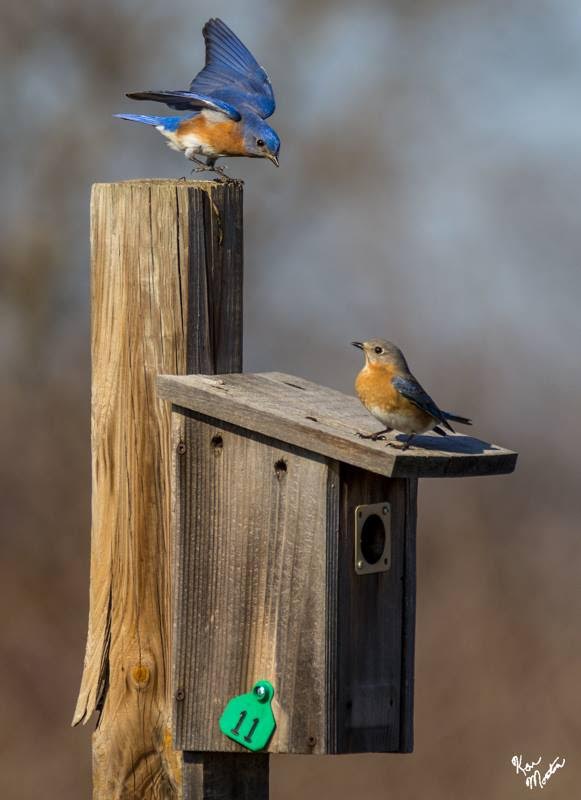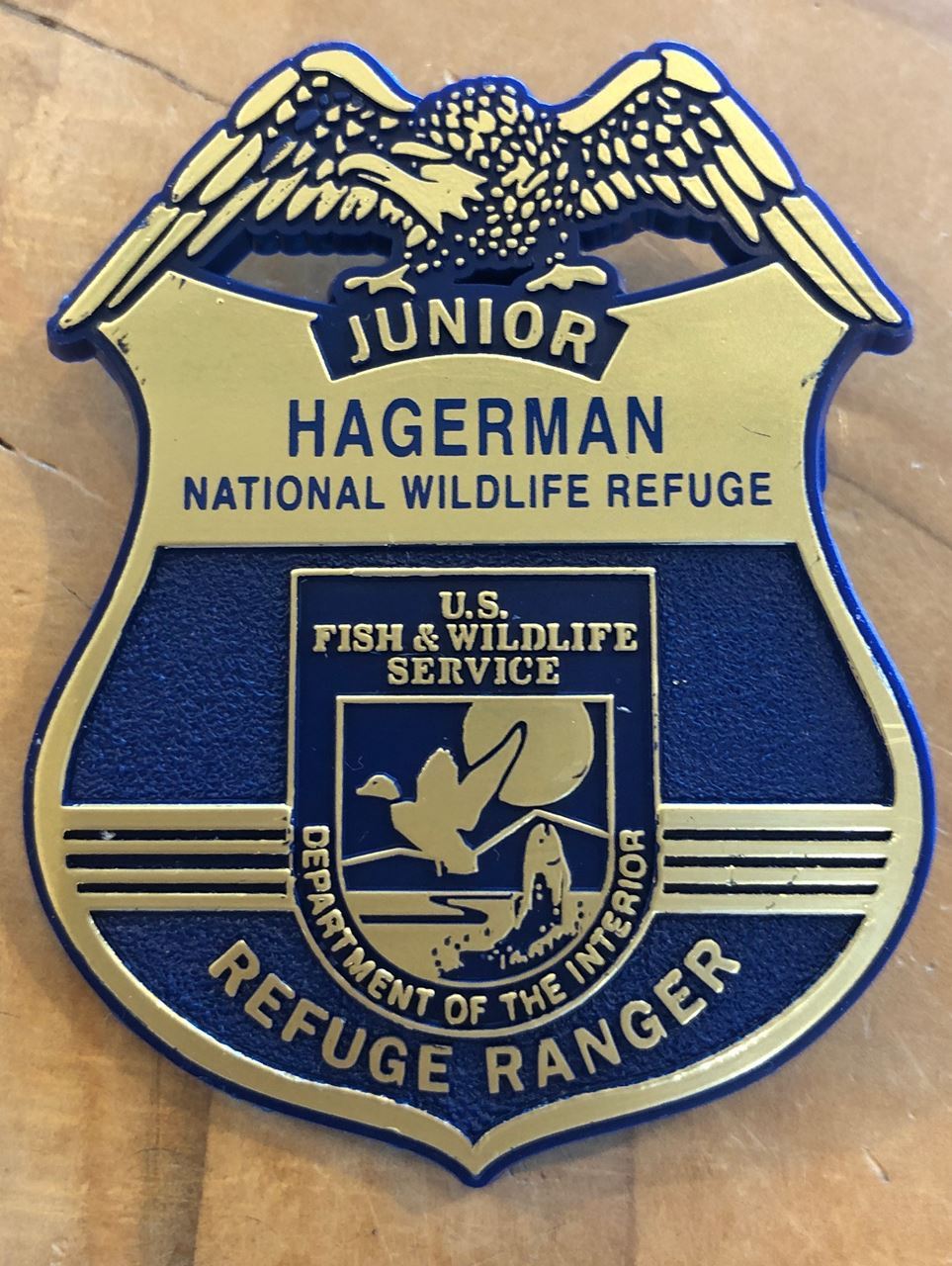Rewilding Sticker Hill: Is it Finally Fall? By Karen Glenn, Blackland Prairie Texas Master Naturalist (BPTMN) Leaves are beginning to drop from trees and shrubs, summer plants are drying out and turning dormant, and the fall bloomers are beginning to slow down a bit as the occasional cooler weather prepares us for the winter ahead. We are currently experiencing another false fall. There may be more summer-like days, but soon cool days will be here. That means it is almost chore time. Purple asters and goldenrod are the dominant plants still actively producing forage for the pollinators on Sticker Hill. The tall gaura is done, for the most part, so the tall stalks are bare giving the impression of a sheer curtain in the areas it gathered. The late boneset and marsh fleabane are taking a break. They will bloom again soon, but for now the goldenrod and asters are doing a good job providing resources for the local bees and butterflies. I visited Hagerman NWR a couple of weeks ago, and the Butterfly Garden was still full of late summer and fall bloomers. One of the most popular plants the day I visited was the Blue Mistflower, Conoclinium coelestinum, which I hope to add to this property soon. It was filled with butterflies, bees, and other pollinators. A Gulf Fritillary, Dione vanilla, and a Common Buckeye, Junonia coenia, on a Blue Mistflower, Conoclinium coelestinum, at the Hagerman NWR Butterfly Garden.The garden is still full of local pollinators and gorgeous blooms. |
Fall is a great time to look over the past growing season to see what worked, what didn’t, and make plans for next year. It is also a great time to seed grass for next season. I have been spreading native grass seeds all month. We seeded the pasture with big bluestem (Andropogon gerardii). Indiangrass (Sorghastrum nutans), and little bluestem (Schizachyrium scoparium). We also added blue grama (Bouteloua gracilis) and sideoats grama (Bouteloua curtipendula) in areas where shorter grasses were needed. There will be no raking of leaves on Sticker Hill but there will be some minor clearing of small trees and shrubs that have popped up over the past few years. I usually wait 2-3 years before deciding whether to take small trees down, but there have been so many volunteer redbud, persimmon, and catalpa trees popping up that many will be removed as seedlings. There is currently too much shade at the front of the property, so this winter we will be removing quite a bit of woody growth. The trees will be used to build a couple of new wood piles, which will provide shelter this winter for the smaller critters on the property. A splitgill mushroom, Schizophyllum commune, colony on an old persimmon branch. This common fungi will rapidly break down smaller trees and branches. When small diameter trees are used, wood piles quickly return to the soil as stored carbon. I will probably burn a small amount when the burn ban is lifted for Grayson County, but not much since burning releases the carbon back into the air as carbon |
dioxide. Allowing fungi to return the trees to the soil adds organic matter rich in carbon and other nutrients. This builds healthy soil and gives soil organisms an abundant energy source. One of my goals is to capture as much carbon as possible with plantings, then return the plant material back to the soil using natural processes. This helps to build and sustain a healthier ecosystem.
This is also the time of year when the local peppervine needs a bit of thinning and clearing. Peppervine, Nekemias arborea, is a native vine in the Grape Family (Vitaceae) with beautiful foliage and colorful berries. Often mistaken for poison ivy, it is an attractive, fast-growing plant, but it may be a poor choice for smaller spaces. Peppervine will take over quickly, if you let it, but it isn’t too difficult to control with a little maintenance.
Peppervine, Nekemias arborea, produces berries which start out white, then alternate with bright blues, reds, and purples until they reach a deep, glossy black color when ripe. The berries are not considered edible by humans and cause throat irritation, but this native vine is favored by many pollinators and songbirds.
Once the berries are eaten by wildlife, the vines are cut at the ground, dried out, and added to a woodpile. Dried peppervine also makes a great fire starter for campfires, and it is recommended to avoid planting near homes and other buildings because of its flammable nature. Some gardeners have referred to this plant as the “plant from hell” but it is native to Texas, so I am trying to learn how to manage it and figure out what companion plants can compete with it to help hold it in check. Many plants have bad reputations mainly because they can outcompete the non-native plants we try to keep in our spaces. I try to evaluate the native plants that appear on Sticker Hill as unbiased as possible. The native Peppervine has not caused a problem yet, but it has an invasive cousin, Amur Peppervine (Amelopsis glandulose) that appeared at the same time. Another name for the invasive species is porcelain berry, and it was sold as an ornamental, due to its colorful berries. It has large heart-shaped and three-lobed leaves, so the two vines are easy to tell apart, even without fruits present. Since it is invasive, it must go!
If you have room for a roaming ground cover or a quick growing semi-evergreen screen, native peppervine might be a good choice. It happily covers the fence along the driveway. With proper support it can grow 30 feet or more in a season, although my vines rarely get over 7-8 feet on the fencing. Peppervine prefers to live on the edges of woods and along fence rows. This plant also has a reputation for taking down smaller trees (which could be beneficial, if trying to weaken or remove woody thickets, especially before a burn). Wildlife of all kinds use this plant from the leaves and flowers to the shiny black berries, although it is not considered edible by humans. The ripe berries have calcium oxalate crystals, which are harmful, if swallowed. If small children are in the vicinity, that may be something to keep in mind. Songbirds and small mammals have no trouble eating the sweet berries, though. If it becomes problematic and must be removed, most of the resources suggest cutting it at ground level and applying a broad leaf herbicide directly to the open cut. Young plants are easily pulled up, roots and all. Fire ant mounds are easier to see in the winter months. A disturbed mound shows eggs the worker ants will bring to the surface after the first treatment. It is important to treat the mound with a second drench of boiling water to eliminate any survivors. The process may be repeated as often as necessary for large colonies. Another chore for this time of year is fire ant control. It is never ending, but this is the time that the spring and summer ground covers dry up, so hidden mounds become visible. I try not to use synthetic baits and poisons on the property and prefer physical methods to remove unwanted invasive species. For fire ants my method of choice is the good old trusty tea kettle! A little gravity and boiling water works wonders to kill the ant colonies, while leaving behind no toxic residue. Plus, it is satisfying hearing the water percolate deeply into the underground passages! The soil provides insulation that holds in heat as it effectively kills the ants. After the first drench, wait about 20-30 minutes, then drench again. Any workers who survived the first round will be moving the eggs and resources up to the soil surface, so a second treatment usually eliminates any survivors that may have been in side passages. If it is an older, deeper mound, more treatments may be needed, but most of the time two tea kettles full of water per mound will suffice. This is the safest and most effective fire ant treatment I have found. It is instantaneous, safe to use around ponds, pets, and livestock, and there are no worries about toxic residues. So, if you see me wandering around out in a pasture with a tea kettle in my hand, I am not out of my mind (although this is debatable), I am stalking fire ants! Read More about Karen Glenn's Rewilding Project |
Upcoming Activities:
The Friends of Hagerman is Hosting 17 Family Friendly Events in November! Donate to help fund programs like these! |
|
The Geese are On Their Way!
Every November thousands of Snow and Ross Geese incredibly make their way to Hagerman NWR from the Arctic Tundra. Photo by Laurie Sheppard Shhhhh...They are Resting The soon to arrive geese at Hagerman National Wildlife Refuge will have recently made an exhausting 3,000-mile trip from the Arctic Tundra. When they finally reach the refuge, they will find their perfect habitat managed by refuge staff, and hundreds of acres of wheat planted just for them. After all, these geese and other migratory birds of all types, are the primary reason our refuge exists! Please come and enjoy the incredible sight of thousands of geese! Please also respect their need to seek refuge and feed in peace: it is critical to their survival to regain their strength through diet and rest. Disturbing the
geese is a federal offense, possibly resulting in hefty fines. |
We've Made Some Changes... We are saddened to announce that, due to the high cost of email services, we must begin limiting the email distribution of the Featherless Flyer to members only. If you enjoy receiving the Flyer every month via email, please consider joining the Friends with a Membership. Individual memberships are $10 per year. The Flyer will always be available, for free, at the beginning of every month via our website or Facebook (Facebook account required.) |
|
|
Available in the Nature Nook while supplies last. Thank You
The Friends of Hagerman extend heartfelt gratitude to all the participants of our recent fundraiser auction. Your generous bids and unwavering support made a significant impact, helping us to raise essential funds for our cause. Each contribution, whether big or small, plays a vital role in driving our mission forward. Thank you for being a part of this special event and for your commitment to making a difference in our community and our environment! The 2024 Refuge Roundup: Raptor Festival A fun time was had by all, and everyone enjoyed the live raptor programs by the Blackland Prairie Raptor Center. Watch for our semiannual festivals on the Second Saturdays in May and October! Photos by Lea Watson |
Second Saturday Hagerman and YOU: The Healing Power of Nature with Laurie Sheppard, Blackland Prairie Texas Master Naturalist (BPTMN) Saturday, November 9 at 10:00 AM in the Visitor Center "Everyone needs beauty as well as bread, places to play in... where nature may heal and cheer and give strength to body and soul" ---John Muir Many scientists and scholars have focused their research on the health benefits of nature. From lowering the risk of cardiovascular disease to improvements in cognitive function; from pain management to wound healing, a multitude of evidence can easily be found linking time spent in nature with increased health and well-being. Many of these positive impacts are available to us all right here at the refuge. Come learn about opportunities to learn and grow, places to find peace and solitude, and activities to strengthen your body and mind. Photo of Harris Creek Trail by Laurie Sheppard After the presentation, the 2024 photo contest results will be revealed! Enjoy the fabulous winning photos! Coming Next Month:
|
Plant of the Month: Passion Vine By Nana Rylander, Blackland Prairie Texas Master Naturalist (BPTMN) If you want a plant with stunning flowers that is sure to attract pollinators – especially the Gulf Fritillary butterfly – make space in your butterfly garden for a passion vine. It can easily be trained to grow on a trellis or chain-link fence. It is hardy, tolerates our hot, dry summers, and can also be used as a ground cover. The plant itself is beautiful, with large five-pointed, deeply fingered leaves, but it has the added attraction of abundant, showy, 4 to 5-inch blossoms (most commonly purplish) that appear all summer and well into the fall. There are many species of passion vines – some with bluish or white blossoms – so select yours from a reputable nursery in our area. The passion vine is the host plant for the Gulf and Variegated Fritillaries, so look for their brown, spiky-looking caterpillars eating away at the leaves, and don't mind their activity. It just means more butterflies on the way. The plant dies back in our winters, but pops out again in late spring (just as you might think it is dead). It is a fast-grower, with low maintenance, and will add much beauty – and many Fritillaries – to your life. |
The perfect Christmas gift for the bird Lover in your family: The Adopt-A-Nestbox Sale is on now!
Every year the Friends of Hagerman gives the public an opportunity to support the Eastern Bluebird population and learn all about them via the Adopt-A-Nestbox Program. Participants of the Adopt-A-Nestbox program will be invited to name their adopted nestbox, and visit it along a Hagerman NWR hiking trail as often as they like. Participants will receive an email every week during nesting season with a picture of the inside of the nestbox and an explanation of its stages of development. An adopted nestbox makes a great Christmas gift! Adopt-A-Nestbox Today! While supplies last. |
Birding with Jack: The Weekly Bird Census
Each Tuesday a team of experienced birders, including Master Naturalist Jack Chiles, Blackland Prairie Texas Master Naturalist (BPTMN), and Ornithologist Wayne Meyer, Phd., traverse 35 miles of refuge roads and hiking trails, documenting every bird they encounter. This Bird Census is reported to The Cornell Lab of Ornithology for use in research, and each week we will bring you a link to their actual bird count, and a summary of their adventures.
Black-bellied Plover, Redheads, and a Gadwall It was a cloudy day with a stiff wind for today's survey. Still no rain and the lake continues to recede exposing more and more mudflats. The star bird the last couple of weeks has been the Red Phalarope and we could not locate it today but it was here this past weekend. Some of the wheat is still ok but some has died out. We are hoping for rain soon. A couple of Ross's Geese arrived this weekend but we could not locate them today, but we did see a lone Snow Goose in Harris Creek Marsh. 8 Wild Turkeys were spotted at the residence near Refuge Rd entering the refuge. Long-billed Dowitchers are still present in large numbers with 306 counted today and we also saw one Short-billed Dowitcher. 13 species of shorebirds were present today. Egrets and herons numbers are way down with only 6 Great Blue Herons, 3 Snowy Egrets and 9 Great Egrets observed today. At Sandy Point we saw a Bald Eagle sitting in a tree on the point to the west. We also had a Pine Warbler there. We saw a Common Yellowthroat on the road to Meadow Pond near the long bridge and there were 153 Gadwalls at Deaver Pond. Winter Sparrows are starting to show up and we saw White-crowned Sparrows, White-throated Sparrows, Savannah Sparrows, Song Sparrows, Lincoln's Sparrows and a Spotted Towhee. We finished the day with 82 species. Today's photos, taken on previous outings, Black-bellied Plover, Redheads, and a Gadwall. Thanks for looking. See the rest of Jack's notes and the latest Bird Census Results |
The Friends of Hagerman NWR Photo Club Photo Contest Winners Announced The 2024 Friends of Hagerman NWR Annual Nature Photography Contest winners will be announced. The Second Saturday program starts at 10:00 AM and the presentation is Hagerman and YOU: The Healing Power of Nature with Laurie Sheppard. After the program, there will be a very short break. Starting at 11:30 AM the Hagerman photography club will present a slideshow of the photo contest winning photographs and awards will be presented. Come to the Second Saturday program and stay for the photo contest awards presentation. We're sure to see some spectacular photos by photographers. For details about the photo contest, click here. Not a member yet? Please join us Photo Club Meeting: Saturday, November 16, 1:00 – 3:00 PM Join us for the November meeting of the Friends of Hagerman NWR Nature Photography Club. We will present a slideshow of the winning photographs of the 2024 Friends of Hagerman NWR Annual Nature Photography Contest. Photo club members, guests, and visitors are welcome to attend meetings. You do not need to be a photo club member to attend. |
| Puddles' Craft Corner By Cindy Steele, Master Naturalist |
Animals…Masters of Disguise!

Welcome back to Puddles’ Craft Corner! Have you ever been exploring in the woods or walking around your backyard and reached down to pick up a leaf and realize that it’s not a leaf at all…it’s alive!? Animals have amazing ways of making themselves almost invisible. This ability is one of their best ways to protect themselves from predators and danger. Let’s learn all the fantastic ways animals truly are the “Masters of Disguise!”
In nature, every advantage increases an animal's chances of survival, and therefore its chances of having babies. Because of this, animal species have developed a number of special adaptations that help them find food and keep them from becoming food. One of the most common adaptations is natural camouflage, an animal's ability to hide itself from predator and prey.
In this article, we'll see how animals blend in with their environment so that others might overlook them. We'll look at a few clever hiders who can change their camouflage with a change in their surroundings. In addition to these expert hiders, we'll look at some animals who don't hide at all but throw predators off by disguising themselves as something dangerous or uninteresting. What Exactly Is Animal Camouflage?
There are four basic types of camouflage: concealing coloration, disruptive coloration...
Continue the Lesson With Full Craft Instructions and other Nature Crafts with Puddles
Junior Ranger Program
|
| The Junior Ranger Pledge As a Junior Ranger at Hagerman National Wildlife Refuge, I pledge to protect outdoor creatures small, big and huge. To keep the water, air and land clean. To make enjoying nature a routine. I will share my new skills with family and friends. When people and nature work together, everybody wins! |
|
Sponsors Enable the Friends to…
Join Today! Memberships available for $10 |
Come, Take a Tour on the Wildlife Explorer! Come join us for a ride on the Wildlife Explorer! Our new and beautiful tram is available for ninety-minute tours of Hagerman every Saturday and Sunday, weather permitting. Our tours are as varied as our drivers. Each tram driver has her/his approach to the tour: you may learn about wildlife, birds, habitat, refuge history, photography, you name it! To paraphrase, “a Wildlife Explorer tour at Hagerman is like a box of chocolates, you never know what you’re going to get.” But you know it’s going to be good! Come see us! Lots of stops for bird-watching and photography. |
Register for a Tram Tour Today! |
|
|
Photo by Cathy Van Bebber | Sunrise at the Little Sit by Laurie Sheppard |
Meet Jack and the Bird Census Team and learn how to identify the birds of North Texas while enjoying the beautiful sunrise over Lake Texoma! Modeled after Cornell's national "Big Sit" event, a group of dedicated birders invite you to join them at sunrise to conduct a bird count as multiple species fly to the water and the surrounding land to feed. Leaders will bring spotting scopes and will provide tips for identification of the many species you will see. This event lasts a couple of hours, but all are welcome to come and go as they please. Participants are advised to bring a chair, binoculars and water. The First Saturday of every month, beginning 30 minutes before sunrise. |
Location: H Pad, Sadler, Texas 76264 (H Pad is in Sadler, but it is part of the refuge) GPS Coordinates: 33.734961, -96.780582
|
|
Early Bird Walk with Jack Chiles Master Naturalist Jack Chiles will lead our Early Birding event, weather permitting. Bring binoculars or borrow ours. Meet at the Visitor Center and return in time for the Second Saturday program. Please Register (Optional) so we may inform you via email of unforeseen changes/cancellations. |
|
Do You Like to Work Outside? The Refuge Needs You! |
It takes a lot of people to have a beautiful garden! The Wednesday Garden Team Love to work with native plants and meet other gardeners? Come and help us add plants, weed and mulch our beautiful butterfly garden. Garden Team volunteers get first dibs on thinned native plants as well as access to seeds and cuttings for propagation. Gardeners meet on most Wednesdays, but times vary. Contact Us to subscribe to the volunteer garden team weekly email. Provide own tools and gloves. Minimum age 18, or 16 if accompanied by parent/volunteer. |
Mowing and Refuge Beautification: The Work Crew Do you enjoy working outside, mowing, sprucing up hiking trails, trimming and removing brush and general cleanup? Show your love for nature by joining the Outdoor Crew at Hagerman National Wildlife Refuge. Outdoor Crew volunteers meet on the First Tuesday and Fourth Saturday of every month. Contact Us for exact times, dates and other details about joining the volunteer Work Crew. Scouts welcome! |
Visitor Center Volunteers Needed! |
Do you enjoy meeting all kinds of people from all over the world, and like-minded people in our area? If yes, consider joining our team of Visitor Center Volunteers. You will greet refuge guests, distribute maps and other refuge information, and make sales in the gift shop. Shifts available every day of the week: Monday through Saturday 9 AM to 12:30 PM and 12:30 to 4:00 PM, Sunday 1:00 to 5:00 PM. Training is provided. Contact Us if interested. |
| Thank You To Our Contributors: Jack Chiles, BPTMN*, Cindy Steele, BPTMN, Karen Glenn, BPTMN, Mayve Strong, Nana Rylander, BPTMN * Blackland Prairie Texas Master Naturalist Refuge Manager: Kathy Whaley Deputy Refuge Manager: Paul Balkenbush Visitor Services Manager: Spencer Beard Friends of Hagerman NWR Foundation 6465 Refuge Road, Sherman, TX 75092 Phone: 903-786-2826 Join us on Facebook: |
Search for any word--do not use quotes for phrases |
Kroger: Stop by the customer service desk at Kroger and link your Kroger Card to the Friends of Hagerman: the Friends will get rewards for every dollar you spend, at no cost to you.
Please add info@friendsofhagerman.org to your contacts to ensure delivery of registration confirmations, account information and the Featherless Flyer
See you at the refuge!



















